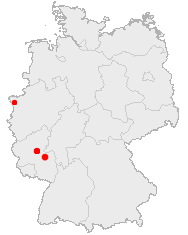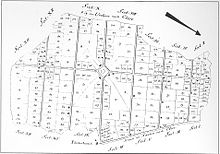Palatinate language island
This article has multiple issues. Please help improve it or discuss these issues on the talk page. (Learn how and when to remove these template messages)
|

The Palatinate language island on the Lower Rhine is an area to the west of the Lower Rhine where since the mid-18th century a Rhenish Franconian dialect has been spoken, brought into the then-Prussian territory by settlers originating from the Palatinate region. Because the Protestants did not mix with the local Catholic population for a long time, their distinct dialect has remained partly preserved.
Geography[edit]
The language island is located in the far west of Germany to the west of the Lower Rhine towards the Dutch border, on the Lower Rhine Heights between the cities of Goch, Kalkar, and Kleve.
Terminology[edit]
The adjective "Palatine" is not regional (historical Palatinate or present-day Palatinate), but rather linguistic. The dialect, later called by the residents of the region "Pälzersch", belongs to the dialects spoken 300 km south in the Nahe-Hunsrück area in the middle of Rhineland-Palatinate and is classified by linguistics into the West Palatine dialect group within the Palatinate dialect and within the Rhenish Franconian.
History[edit]
Beginnings[edit]
In May 1741, the Palatine settlers intended to emigrate to the North American colony of Pennsylvania via Rotterdam. They were a larger group from the Palatinate upper bailiwicks of Kreuznach on the Nahe River and Simmern in the Hunsrück region (both cities are now located in Rhineland-Palatinate).[1] They attempted to escape the poor economic conditions in their homeland.
However, due to the War of Jenkins' Ear, not all prospective emigrants received passage to America. The Dutch border posts were instructed to only allow immigrants into the country who could prove passage to North America. For this reason, the Palatine emigrant group was detained at the Dutch border fortress of Schenkenschanz (now in North Rhine-Westphalia). Negotiations with an English ship captain failed because the emigrants deemed the price too high and refused to accept it.[1][2]
The Rhine boatmen, who were supposed to transport the emigrant group further to Rotterdam, were not ok with their ships being stuck at the Prussian-Dutch border and demanded payment. The settlers subsequently occupied the ships and only released them after receiving an eviction order from the Kleve War and Domain Chamber.

Afterward, 20 families comprising approximately 120 individuals decided to forego emigration and requested settlement land in the region. Their request was forwarded to the Prussian magistrates and judges of Emmerich, Goch, Huissen, and Kleve. The city of Goch possessed the Goch Heath, a 10,000-acre area, which had been gifted to them in 1458 by Arnold von Egmond, Duke of Geldern. This land was made available to the Palatines, who referred to themselves as "Pfälzer".[1] It was only about 250 km away from their homeland.
In the following years, the emigrants struggled with initial financial difficulties, leading to repeated expulsions. Therefore, they submitted a petition to King Frederick the Great. On 30 April 1743, Frederick instructed the Kleve War and Domain Chamber and the Goch Magistrate in a special decree to support this community.
Community Foundations[edit]
Pfalzdorf[edit]

The settlement area in Goch Heath was named Pfalzdorf in 1749.[3] After the initial successes of the colonists, the Prussian authorities became interested in further immigration. Until 1771, additional families settled there, almost exclusively from the Hunsrück region. After that, the heathland was almost completely allocated.[2]
The lease agreement for the settlement sites did not allow for sale or division; therefore, many offspring saw re-emigration as the only way out. The first wave of emigration went to Bönninghardt near Sonsbeck, Königshardt near Oberhausen, Asperheide near Goch,[3] and to Pfalzdorf, Plaggenburg, and Dietrichsfeld in East Frisia.
Louisendorf[edit]

At the beginning of the 19th century, the settlement space in East Frisia was used up, but there was still a need to expand. Therefore, a settlement of the Kalkar Forest was proposed. On 30 September 1820, Friedrich Wilhelm III signed an order making the establishment of the colony legally binding. At the request of the colonists, the new settlement was to be named Louisendorf after Queen Louise.[2]
Neulouisendorf[edit]
Since not all willing settlers could be accommodated in the settlement of Louisendorf, another forest area was considered in 1826. On 31 December 1827, King Friedrich Wilhelm signed the order for the foundation of Neulouisendorf. On 4 June 1832, the portions were assigned, and settlement began. Contrary to the plan to be an extension of the Louisendorf settlement, Neulouisendorf became an independent community.
Consolidation[edit]

In Pfalzdorf, a Reformed church was already inaugurated in 1775, and a Lutheran church on 29 October 1779. On 11 September 1811, the inauguration of a Catholic church followed. This expansion of infrastructure, which also facilitated the practice of religion for incoming Catholics, contributed to a largely autonomous community.
Louisendorf belonged to the Amt Till. However, its own Evangelical parish was established, and its Elizabeth Church was inaugurated on 13 November 1861.
Neulouisendorf was part of the city of Kalkar. Here too, its own Evangelical parish was established. The Evangelical church in Neulouisendorf was inaugurated on 7 June 1898.
With the first municipal reorganization program in North Rhine-Westphalia on 1 July 1969, Pfalzdorf became a district of Goch, and Louisendorf belonged to the part of the Amt Till that was incorporated into Bedburg-Hau.[4]
Independence[edit]
Religion[edit]
The Protestant denomination separated the "Palatines" from the Catholic surrounding area. There were hardly any interfaith marriages, so traditional "Palatine" family names, such as Puff, Hans, Saueressig, Imig, and Thomas, have been preserved. Elements of tradition were also passed down, such as the practice of mentioning the surname before the first name (thus, Imig Fritz and not Fritz Imig). Furthermore, Catholic customs widespread in the Lower Rhine were not adopted.[2]
Language[edit]
Due to settling in close quarters, the "Palatines" became a minority group that nurtured and developed their own dialect. This was encouraged by the aforementioned marriage policies and by the establishment of their own elementary schools, which existed until the 1940s. Originally, the settlers exhibited linguistic peculiarities stemming from their different regional origins: Bad Kreuznach and Simmern are about 35 km apart and separated by the 650 m high Soonwald; Simmern belongs more to the Moselle Franconian, while Kreuznach to the Rhenish Franconian linguistic area. In the settlement area, both dialects gradually merged into a general dialect known as "Pälzersch," which also incorporated features of the surrounding Low Franconian or Ripuarian dialects. Presently, "Pälzersch" is still regularly spoken by older residents. The younger population typically switches to Standard German upon starting school and loses their dialect competence. Therefore, the preservation of "Pälzersch" is threatened. Jakob Imig was a dialect poet and local historian, after whom the Jakob Imig Archive in Louisendorf,[5] based on his collection, is named. The LVR Institute for Regional Studies and History in Bonn also refers to him as "the most well-known Palatine"[6] from the Lower Rhine Palatinate language island.
Further reading[edit]
- Emil Böhmer, Sprach- und Gründungsgeschichte der pfälzischen Colonie am Niederrhein (Dissertation), Marburg 1909.
- Peter Honnen, Cornelia Forstreuter, Sprachinseln im Rheinland : Eine Dokumentation des Pfälzer Dialekts am unteren Rhein und des „Hötter Platts“ in Düsseldorf-Gerresheim, in Rheinische Mundarten 7, Köln 1994, ISBN 3-7927-1456-6.
- Barbara Mott, Pfälzer am Niederrhein : Die Geschichte der Pfälzersiedlungen Pfalzdorf, Louisendorf und Neulouisendorf im Rahmen der preußischen Binnenkolonisation des 18 und 19 Jahrhunderts, Völkersche Buchdruckerei und Buchhandlung, 1989.
- René Schiering, Zur Dokumentation des Pälzersch in Pfalzdorf, Louisendorf und Neulouisendorf (Niederrhein) : Bericht eines zweiwöchigen Feldforschungsaufenthaltes, in GBS Bulletin 10, 2004.
Reference list[edit]
- ^ a b c Böhmer, Emil (1909). Sprach- und Gründungsgeschichte der pfälzischen Colonie am Niederrhein.
- ^ a b c d Mott, Barbara (1989). Pfälzer am Niederrhein.
- ^ a b Helmut Lange: Archived 2007-08-10 at the Wayback Machine, 23. Juni 2006.
- ^ Martin Bünermann (1970), Die Gemeinden des ersten Neugliederungsprogramms in Nordrhein-Westfalen, Köln: Deutscher Gemeindeverlag
- ^ "Jakob-Imig-Archiv". Pfälzerbund am Niederrhein. Retrieved 2021-04-17.
- ^ "Pfälzische Sprachinsel am Niederrhein". LVR-Institut für Landeskunde und Regionalgeschichte. Retrieved 2021-04-17.
